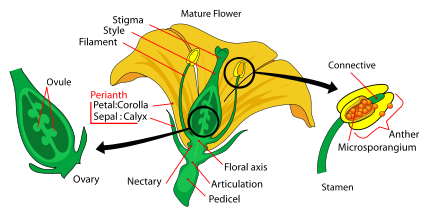Reproduction
As stated on the Classification page, American witch hazel is an Angiosperm, and like all other angiosperms witch hazel reproduces through its flowers and seeds. Unlike almost all other flowering plants, witch hazel’s flowers typically bloom from late September through late November. This is usually after all of the leaves have dropped on deciduous plants and the first frost has already occurred in the area. The flowers of witch hazel consist of four yellow petals that alternate with four short and stubby stamens. The stamens hold the anthers, which produce the witch hazel’s pollen. The pollen produced tends to be of the sticky nature with small grains and is very abundant. These characteristics of witch hazel pollen make it desired by many insects. The insects, mainly gnats and bees, will carry pollen from the anther of one witch hazel flower to the stigma of a flower on a different witch hazel shrub. The stigma contains the female ovary of the flower and contains two ovules, also known as eggs. Once pollen is transferred to the stigma the flower is now said to be pollinated (Anderson and Hill 2002).
The picture found below illustrates the
reproductive organs found on the witch hazel shrub. The anther,
stamen and stigma with an ovary and ovules are all clearly labeled.

An interesting characteristic of witch hazel reproduction is the fact that the fertilization of the ovules in the female ovary does not occur immediately after pollination. In fact, pollination occurs in late September until late November, while fertilization will not occur until the spring after the pollination.
http://en.wikipedia.org/wiki/File:Mature_flower_diagram.svg
Once fertilization occurs, the ovary will begin to develop into a woody fruit. The fruit will reach its maturity usually in late August. This fruit now contains two seeds, which were once the two ovules but have been fertilized with pollen to become seeds. The seeds of the fruit will be ejected, sometimes up to 15 feet away from the original witch hazel shrub. These seeds, with the right Nutrition can grow into mature witch hazel shrubs (Anderson and Hill 2002).
Under ideal conditions every ovule that is fertilized will grow into a mature witch hazel shrub...but we all know this is not always possibly. Check out some different interactions between witch hazel and other organisms that can prevent these ideal conditions. To go back to the homepage click here.